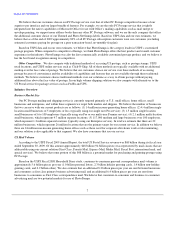Stamps.com 2009 Annual Report Download - page 20
Download and view the complete annual report
Please find page 20 of the 2009 Stamps.com annual report below. You can navigate through the pages in the report by either clicking on the pages listed below, or by using the keyword search tool below to find specific information within the annual report.
TABLE OF CONTENTS
Risks Related to Our Stock
The tax value of our net operating losses could be impaired if we trigger a change of control pursuant to Section 382 of the
Internal Revenue Code.
We currently have federal and state net operating loss (“NOL”) carry-forwards of approximately $230 million and $150
million, respectively, with potential value of up to $94 million in tax savings over the next 15 years. Under Internal Revenue
Code Section 382 rules, if a “change of ownership” is triggered, our NOL asset may be impaired. A change in ownership can
occur whenever there is a shift in ownership by more than 50 percentage points by one or more “5% shareholders” within a
three-year period. We estimate that as of December 31, 2009 we were at approximately a 26% level compared with the 50%
level that would trigger impairment of our NOL asset.
Under our certificate of incorporation, any person, company or investment firm that wishes to become a “5%
shareholder” (as defined in our certificate of incorporation) must first obtain a waiver from our board of directors. In addition
any person, company or investment firm that is already a “5% shareholder” of ours cannot make any additional purchases of our
stock without a waiver from our board of directors. These NOL protective measures contained in our certificate of incorporation
(the “NOL Protective Measures”) are more particularly discussed in our Definitive Proxy Statement filed with the Securities and
Exchange Commission on April 2, 2008.
As of February 28, 2010, we had 14,287,786 shares outstanding, and therefore ownership of approximately 715,000 shares or
more would currently constitute a “5% shareholder”. We strongly urge that any stockholder contemplating owning more
than 600,000 shares contact us before doing so.
Although the NOL Protective Measures are intended to reduce the likelihood of an “ownership change”, we cannot ensure
that an “ownership change” will not occur.
Section 382 of the Internal Revenue Code is an extremely complex provision with respect to which there are many
uncertainties. Accordingly, the NOL Protective Measures may not prevent all transfers that might result in an “ownership
change.” Alternatively, a court could find that some or all of the NOL Protective Measures are not enforceable, either in general
or as to a particular fact situation. Even if the NOL Protective Measures are enforced by state courts, we have not requested a
ruling from the Internal Revenue Service (“IRS”) regarding the effectiveness of the NOL Protective Measures, and we cannot
ensure that the IRS will agree that the NOL Protective Measures are effective for purposes of Section 382. Moreover, our board
of directors can permit a transfer or transfers that result in or contribute towards an “ownership change” if it determines that such
a transfer is in our best interests. As a result of these and other factors, the NOL Protective Measures serve to reduce, but do not
eliminate, the risk that we could undergo an “ownership change.” Therefore, we cannot assure you that upon audit, the IRS
would agree that all of our NOLs are allowable.
Our charter documents, including the NOL Protective Measures, could deter a takeover effort, which could inhibit your
ability to receive an acquisition premium for your shares.
The provisions of our certificate of incorporation, bylaws and Delaware law could make it difficult for a third party to
acquire us, even if it would be beneficial to our stockholders. In addition, we are subject to the provisions of Section 203 of the
Delaware General Corporation Law, which could prohibit or delay a merger or other takeover of our company, and discourage
attempts to acquire us.
In addition, the NOL Protective Measures could be deemed to have an “anti-takeover” effect because, among other things,
they restrict the ability of a person, entity or group to accumulate more than 5% of our common stock and the ability of persons,
entities or groups now owning more than 5% of our common stock to acquire additional shares of our common stock without the
approval of our board of directors. As a result, our board of directors may be able to prevent any future takeover attempt.
Therefore, the NOL Protective Measures could discourage or prevent accumulations of substantial blocks of shares in which our
stockholders might receive a substantial premium above market value and might tend to insulate management against the
possibility of removal.
16
























